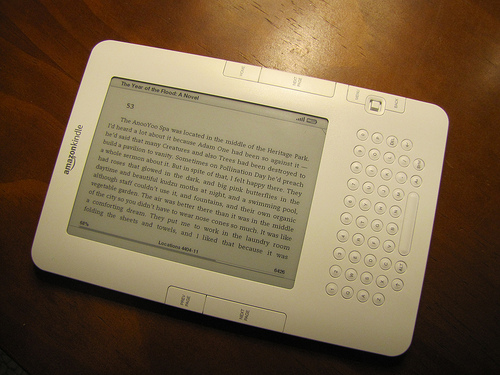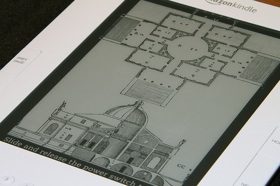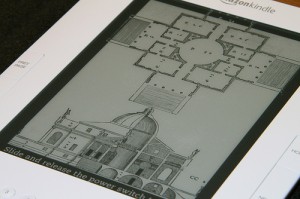Why Schools Should Switch To Kindle E-Readers
 In October of 2009 USA today released an article discussing Cushing Academy in Massachusetts and the school library’s decision to rely upon the Amazon.com Kindle e-reader for almost all of their book circulation needs. While this is the first major coverage of an almost full conversion to digital readers for a school library, more and more school libraries have begun to utilize Kindle devices in some capacity.
In October of 2009 USA today released an article discussing Cushing Academy in Massachusetts and the school library’s decision to rely upon the Amazon.com Kindle e-reader for almost all of their book circulation needs. While this is the first major coverage of an almost full conversion to digital readers for a school library, more and more school libraries have begun to utilize Kindle devices in some capacity.
In many cases, one of the primary complaints of parents, teachers, and librarians not in favor of the Kindle being implemented in school libraries is that it is a somewhat expensive device with an average price tag of approximately $260-$470 depending on the model purchased. While this may seem like an inordinately huge price tag for an educational library to pay for a new piece of equipment, it is important to consider other variables.
One new hardcover book, in particular a non-fiction title, is usually going to cost a school library $20-$30 if a standard hardcover is purchased. Should a library edition of available titles be purchased, the cost increases. Almost all new books and bestsellers cost only $9.99 on the kindle, which equates to a $10 to $20 savings per book. A school library that purchases 20 books in a month will instantly pocket the cost of a Kindle unit in savings and will only have to purchase the book once to have it instantly available in the library’s kindle account.
An added bonus that comes with switching over to a Kindle based library is that it does not have to be limited purely to the number of handheld devices owned by the school or school system. Kindle now has a reader for PCs and a Kindle reader application for iPhones and the iPod Touch. Each of these applications allows a Kindle owner the ability to read a book in their Kindle account when they do not have access to their Kindle unit.
Any notes or highlighted sections will automatically synchronize and be visible on the PC and/or iPhone screen. This option could be particularly useful in literature classes where book selections are read both independently and in the classroom. A student who takes notes on a school library provided Kindle device during class can access those same notes at home on their PC in preparation for a test. Future upgrades to the Kindle and iPhone readers aim to allow the addition of notes to the PC and iPhone books as well.
As Kindle technology continues to develop, it will surely offer many more features targeted towards school and public libraries. Whether it is a full or partial implementation, e-readers should have a place in any technologically advanced educational system and the individual school libraries within them.
Image by http://www.flickr.com/photos/jcwestbrook/ / CC BY-ND 2.0
E-Readers in Education
 Within a relatively short time frame, Amazon.com launched the Kindle followed by Kindle 2 and Sony launched its latest electronic reader. On the heels of these two revolutionary e-readers, Barnes & Noble will be releasing Nook, their version of an electronic book. Unlike e-readers of the past, these new models offer many features that have school systems and some education advocates pondering whether Kindles or other e-readers should be incorporated into the classroom either in place of or as a supplement to traditional textbooks.
Within a relatively short time frame, Amazon.com launched the Kindle followed by Kindle 2 and Sony launched its latest electronic reader. On the heels of these two revolutionary e-readers, Barnes & Noble will be releasing Nook, their version of an electronic book. Unlike e-readers of the past, these new models offer many features that have school systems and some education advocates pondering whether Kindles or other e-readers should be incorporated into the classroom either in place of or as a supplement to traditional textbooks.
E-Readers offer numerous benefits when incorporated into a classroom setting or an entire educational system. These benefits range from economics to quality of learning and are far reaching enough to demand an audience.
In terms of finances, a standard e-reader will run between $200-300 at current prices. In a public school system, students are typically issued at least six textbooks (math, grammar, literature, science, social studies, an elective, and the potential seventh alternate – health) per year. At an average cost of $75-$100 per new textbook, the e-Reader (even after books were purchased and loaded) would be a comparable price and certainly no more expensive.
A major benefit of using an e-reader in the classroom shines through when one considers the publication date of textbooks. In many schools most textbooks are used for several years in a row. As physical books they cannot be updated and are used even after they are no longer current or are out of date altogether. If e-readers were utilized the books could be updated electronically as new editions were available and cutting edge scientific discoveries or important current events could be studied through publisher provided enhancements.
Another advantage shows up under the heading of note taking. In primary education, students are typically not allowed to write in books or highlight within the text and instead rely on taking pen and paper notes referencing particular passages to study or vocabulary words to look up. With an e-reader, pen and paper notes can become obsolete as a student can digitally underline or highlight important passages and use marginal notations to add supplemental information provided during lectures. Since personalized notes can be stored in a “cloud” provided by the e-Reader manufacturer, if a device malfunctioned this material could be restored. A student could rest assured they would maintain all of their notes from the beginning of a school course to the end within their e-textbook.
E-Readers take nothing from the current educational system but stand to add a lot to the learning experience. In terms of portability, value, and capability, e-Readers could be the next necessity in the classroom and the educational system at large.
Photo credit http://www.flickr.com/photos/ivyfield/ / CC BY 2.0
Kindle or Laptop: Which is Better for Students
 Some schools are attempting to get laptops assigned to every student to help students prepare for a world where computer literacy is becoming an increasingly important ingredient for success. With netbooks costing as low as $250, it seems like a no brainer to equip every child with a portable PC. But then there is the question of whether computer literacy is more important than book literacy. Reading is still an essential part of learning and a lot can be learned from reading books. If you think reading is more important, then you might advocate that every student get assigned a kindle e-book reader.
Some schools are attempting to get laptops assigned to every student to help students prepare for a world where computer literacy is becoming an increasingly important ingredient for success. With netbooks costing as low as $250, it seems like a no brainer to equip every child with a portable PC. But then there is the question of whether computer literacy is more important than book literacy. Reading is still an essential part of learning and a lot can be learned from reading books. If you think reading is more important, then you might advocate that every student get assigned a kindle e-book reader.
Here’s a quote from a Scholastic article
Kindles stocked with well-chosen e-books would also allow teachers to flex new teaching strategies, according to Cornelia Brunner, the deputy director at the Center for Children and Technology in New York City. “You could have a very nicely selected group of readings. . . . Kids could read, annotate, and actually clip and be asked to make connections among those clippings,” says Brunner.
Other possible benefits include providing students with more books electronically than is practical in print, reducing photocopying, relieving the unhealthy weight of student backpacks, and—though this case is far from proven—saving school districts money on textbooks.
An education think-tank led be former Clinton advisor Thomas Z. Freedman, even proposed giving a Kindle to every student in the country in a paper titled A Kindle in Every Backpack. According to the paper:
We shouldn’t wait a decade or two to begin to achieve what is inevitable — an education system where each American schoolchild has an eTextbook, like Amazon’s Kindle, loaded with the most up-to-date and interactive teaching materials and texts available,” the paper argues. “The ‘Kindle in every backpack’ concept isn’t just an educational gimmick—it could improve education quality and save money.
One solution may be to use an ebook reader application on the laptops so students can have the best of both technologies.
Do you think it would be more effective for students to have laptops or ebook readers?
Photo by Yutaka Tsutano
Get Free Books Via the iPod Touch
 As the summer approaches some lucky students will be assigned summer reading. I say lucky because not all students are intellectually stimulated during the summer hiatus from school. They might be assigned classic literature like The Hobbit or Alice in Wonderland. In the past you would might have to request a hold from your local library or purchase the book from a book store. However, now with the magic of the internet, you can access many classic books for free through sites like Project Gutenburg. If you have an iPod touch, which is basically a hand held computer, you can use programs like Stanza, Wattpad or the Kindle app to turn your iPod into an ebook reader.
As the summer approaches some lucky students will be assigned summer reading. I say lucky because not all students are intellectually stimulated during the summer hiatus from school. They might be assigned classic literature like The Hobbit or Alice in Wonderland. In the past you would might have to request a hold from your local library or purchase the book from a book store. However, now with the magic of the internet, you can access many classic books for free through sites like Project Gutenburg. If you have an iPod touch, which is basically a hand held computer, you can use programs like Stanza, Wattpad or the Kindle app to turn your iPod into an ebook reader.
Wattpad
This ebook reader application for iPod touch gives you free access to 100,000 titles including Frankenstein, War of the Worlds, Romeo and Juliet, Alice in Wonderland, The Adventures of Sherlock Homes, and many more. It even automatically scrolls the pages for you at whatever speed you set it to.
Stanza
Probably the best iPod application for free books. It gives you access to several sites with free ebook downloads like Project Gutenburg and Manyreads.net and the application lets you download the ebooks straight from these sites and start reading immediately.
Kindle App
You can get many ebooks for free using this app like The Three Musketeers, but it is mostly geared to selling books which are typically $9.99. You can also sample virtually any book which is like being in a virtual bookstore.
The Kindle as a Learning Tool
 The Kindle 2 is a really great tool for learning, although the price ($359 for a Kindle 2) may be restrictive. The Kindle is the best e-book reader currently on the market, mainly because of it’s ability to wirelessly access the Amazon store for free from virtually anywhere. In about a minute you can download a digital book to your Kindle which are usually cheaper than the paperback copy. There are several other useful features that make it one of the best learning tools available, if your school can afford it.
The Kindle 2 is a really great tool for learning, although the price ($359 for a Kindle 2) may be restrictive. The Kindle is the best e-book reader currently on the market, mainly because of it’s ability to wirelessly access the Amazon store for free from virtually anywhere. In about a minute you can download a digital book to your Kindle which are usually cheaper than the paperback copy. There are several other useful features that make it one of the best learning tools available, if your school can afford it.
Browse previews of virtually any book
Most books that were recently published are available at the Kindle store. One of the cool features of having a Kindle is that it is like having a book store in your hand. The Amazon store lets you preview the first chapter or the first dozen or so pages of any book that is available.
Holds 3,500 books
Instead of carrying around heavy books, having a digital copy can be pretty convenient. It is nice to be able to access your entire library.
Text books will be available
The new DX version of the Kindle has a 9.7 inch display, which makes it easier to read textbooks. According to The Times Online,
“Three textbook publishers – Pearson, Cengage Learning and John Wiley & Sons, which between them publish 60 per cent of all higher-education textbooks – have agreed to sell books on the device.”
This may or may not save students or schools money depending on the cost of the digital copies compared to the hard back editions.
Free Classics
You can get lots of free classics books on your Kindle. I recently downloaded The Three Musketeers for free. There are some available at the Kindle store but you can also Google “Free Kindle Books”.
Free Internet
One of the best features on the Kindle is the “experimental” internet browser. Although, Amazon could get rid of this feature at anytime since it is advertised as “experimental” it seems unlikely that they would without a significant consumer backlash. This feature is great for browsing text sites and works virtually anywhere where a cellphone would work.
Upload Documents
You can email documents to Amazon, which will convert and upload them to your Kindle for a small fee, or you can do this yourself. If you convert the text to a .txt you can upload it from your computer to your Kindle.
At $359, it may be smarter to invest in a netbook which can cost less than $300. Nevertheless, it is a great educational tool if it can be put in the hands of students.
Photo by treydanger